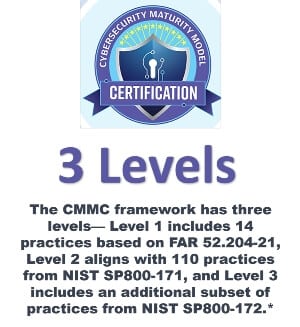
CMMC IT control over the remote access and sharing of CUI unstructured data is achieved via a zero-trust data access platform to improve security, increase productivity, and simplify file management and control, making it an attractive option for DIB organizations to meet CMMC requirements.
CMMC IT Control for DIB Organizations Over Remote Access and Sharing Using Zero Trust Architecture
Estimated reading time: 4 minutes
Table of Contents
Unstructured Data Stored by DIB Organizations

DIB organizations may store various types of unstructured data such as sensor data, maintenance logs, incident reports, images and videos, emails and other communications, engineering diagrams and plans, project plans, accounting and financial data, medical files, legal files, and general office files used in everyday activities such as MS Office, Adobe and CAD files.
Zero Trust Mechanisms for IT Management
A zero trust architecture provides mechanisms that provide the IT department of DIB organizations control over the remote access and sharing of their CUI unstructured data. Using a management console, IT can administer users, groups, access and permissions of storage repositories, file sharing and security. Administration capabilities include:
Provides Centralized Control
- IT departments can centrally manage and control all remote access and file-sharing activities. This includes setting user permissions, creating access policies, monitoring file activity, and revoking access when needed.
Secures Remote Access
- Security protocols protect remote access to files stored on company servers, SharePoint or in cloud storage accounts. This reduces the need for employees to download and store sensitive files on their local devices, thereby reducing the risk of data breaches and cyber-attacks.
Includes Activity Logging
- Since all user activities are controlled via the zero trust policy server, IT is provided an activity log of who accessed which files. The activity log can be exported to the organization’s SIEM where it can be used as a data source to flag suspicious behavior and aid in forensic investigation to help identify and respond to potential security risks.
Integrates and Federates Existing Storage Investments
- The zero trust architecture integrates with and federates existing file storage systems, such as server-attached storage (DAS, SAN) network-attached storage (NAS) devices, SharePoint, OneDrive, Azure, Amazon and Google allowing IT to extend their security controls to the remote access and sharing these systems and provide a consistent security posture across the organization.
Improves User Management
- IT can set user permissions and control access to the storage and files they each user can access.
Brings Secure, Controlled Storage and Sharing Management
- IT can restrict file sharing of sensitive documents, and control permissions and user access over storage repositories such as view-only, editing not permitted, downloading not permitted, and uploading not permitted.
Supplies Decentralized Enforcement
- The management console allows IT administrators to provide subsidiaries, partners and supply chains to add their storage repositories and users as siloed tenants while the centralized IT administrator maintains control, visibility and access over all tenants.
Supports Interoperability
- It can be integrated with existing investments in IAM, U2F, and SSO as well as your existing storage to minimize disruption and maximize efficiency.
Brings Scalability, Reliability and Performance
- A high-availability server cluster ensures that the solution can scale to meet the needs of the organization, is reliable, available to users, has adequate performance and does not slow down or impede user productivity.
Is Cost Effective
- Flat fixed pricing per user with no cost creep, that leverages your existing storage investments, infrastructure and IT resources, and can reduce the use of VPNs and cloud storage.
The Benefits of Zero Trust Data Access for IT Control Over Remote Access to CUI
Zero Trust Data Access as implemented by FileFlex Enterprise provides administration capabilities of centralized control, secure remote access, activity tracking, integration and federation of existing storage, user management, sharing management, decentralized enforcement, interoperability, scalability and cost-effectiveness. The benefits of the IT control over access and sharing of critical infrastructure include:
Improves Security
- A suite of security protocols to enable remote access to files stored on company servers or in cloud storage accounts. These reduce the risk of data breaches and cyber-attacks.
Provides Tools for Improved IT Management
- IT departments can centrally manage and control remote access and file-sharing activities, including setting user permissions, creating access policies, monitoring file activity, and revoking access when needed. This helps ensure that only authorized personnel have remote access to sensitive data, reducing the risk of data breaches and ensuring compliance with regulatory requirements.
Enables Granular Permissions
- IT can set granular permissions for individual users or groups, controlling who can access which files and folders, and what they can do with them (view, edit, download, etc.). This also helps to ensure that only authorized personnel have access to sensitive data, reducing the risk of data breaches and aiding compliance with CMMC requirements.
Increases Productivity
- Users can access and share files from anywhere, at any time, on any device, without the need for a VPN or other remote access tools. This can save time and improve productivity, as employees can work from anywhere, on any device, without having to transfer files between different platforms or use multiple apps.
Simplifies Management
- Simplifies file management and control for IT departments by integrating with existing file storage systems, such as network-attached storage (NAS) devices, SharePoint, and cloud storage with a unified management console. This can help to reduce the risk of data breaches and aid compliance with regulatory requirements.
Summary
Zero Trust Data Access as implemented by FileFlex Enterprise provides IT departments of DIB organizations with unprecedented IT control over the remote access and sharing activities of their CUI unstructured data. It helps DIB organizations improve security, increase productivity, and simplify file management and control, making it an attractive option for DIB organizations that need to adhere to CMMC requirements.
Learn More About FileFlex Sign Up for a Free Trial